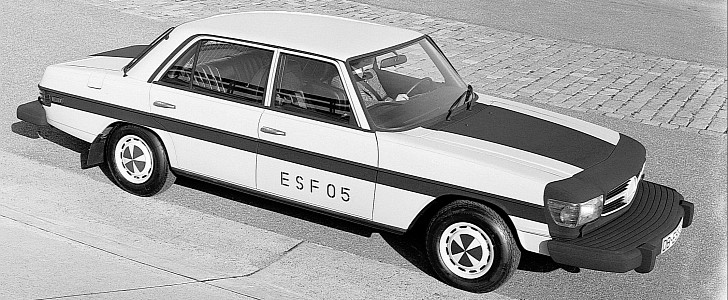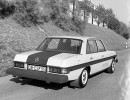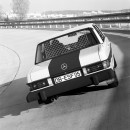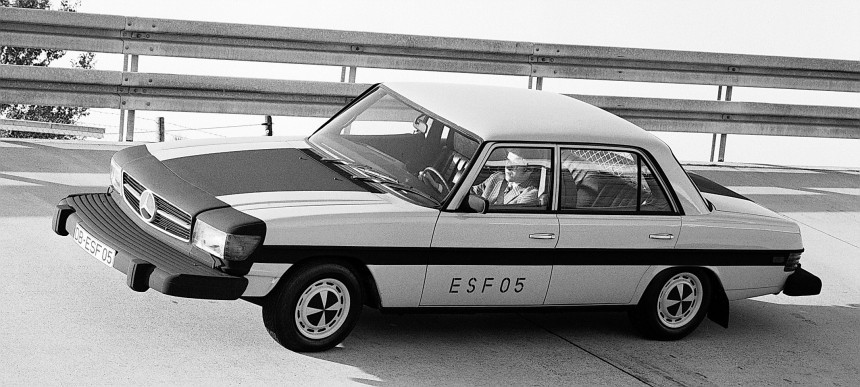What comes to mind when you hear automotive safety? I suppose Volvo, the company that introduced the three-point seatbelt in 1959. But contrary to popular opinion, Mercedes-Benz has been at the forefront of automotive safety since 1956 when the Stuttgart-based outfit was testing parts for their behavior in an accident with special carriages.
It’s also worth remembering that a gentleman by the name of Karl Wilfert, who used to be the head of body development at the Sindelfingen plant, filed a patent for the safety door lock in 1949. The wedge-pin safety lock entered series production in 1959 with the resplendent W111 Heckflosse.
1959 also marks the year the passenger safety cell saw the light of series production. Invented by the father of automotive passive safety, Béla Barényi, the safety cell was rolled out by the aforementioned Heckflosse.
Come August 1967, the safety steering system became standard on every Three-Pointed Star in the lineup. This piece of technology consists of a steering column that telescopes in a head-on collision and an impact absorber that reduces the risk of injury on impact with the steering wheel.
But alas, cars were not safe enough in the event of a crash back then. In 1970, for example, no fewer than 19,193 people were killed on the roads of West Germany. It’s a very sad record that surpasses the number of road fatalities today, 31 years after West Germany reunited with East Germany.
There was a similar development in many other countries, including the United States of America where the Department of Transport launched an experimental safety vehicles program in 1968. The U.S. government helped found the European Enhanced Vehicle-safety Committee in 1970, a well-intended organization supported by Mercedes from the very beginning.
The EEVC was tasked with producing its own experimental safety vehicles, which brings us to the ESF 05 based on the W114 model series penned by the legendary Paul Bracq. You know, the guy responsible for the 600 Grosser, first-generation 3 Series, and the BMW Turbo Concept from 1972 that inspired Giorgetto Giugiaro to create the M1 mid-engine sports car.
Presented in October 1971, the ESF 05 pioneered the anti-lock braking system we take for granted these days. It also features several airbags, including airbags in the front seats' backrests for the rear passengers. The quirky sedan further boasts the seatbelt pretensioning system that locks the belt into place in the event of a crash, restraining the occupant as quickly as possible while protecting the occupant from seatbelt-inflicted injuries.
The weird-looking bumpers aren't there for show; they are 655 millimeters (almost 25.8 inches) longer than the car on which it's based, the ESF 05 had to meet the draconian front, and rear impact requirements dreamt up by the EEVC. It was 655 kilograms (1,444 pounds) heavier than the W114 four-door sedan, and this fellow received a V6 instead of the original straight-six engine to gain space for deformations. Impact-absorbing sheet metal in the front passenger area of the dashboard and polyurethane foam padding also have to be highlighted.
Merc didn't stop here, though. The automaker's engineers decided to eliminate the vent windows up front, and electric window regulators led to the omission of crank handles. Range control and a washer system for the headlamps also need to be mentioned, along with laminated glass for the windshield and rear window. In comparison, the tempered glass breaks into small pieces, laminated glass cracks but remains together, decreasing the risk of injury.
To sum things up nicely, the ESF 05 looks the way it does because the requirements for experimental safety vehicles were pretty serious for the automotive industry of the early 1970s. More specifically, requirements included front and rear impacts with a fixed obstacle at 80 kilometers per hour (50 miles per hour) and the side impact with a pole at 20 kilometers per hour (12 miles per hour). What’s more, the Mercedes-Benz ESF 05 had to withstand minor accidents at up to 16 kph (10 mph) without permanent deformation at the front or rear end, hence the extra long bumpers.
From 1971 through 1974, the German automaker developed a total of 35 experimental safety vehicles for the ESF program. The ESF 2009 S 400 Hybrid Concept from 2009 serves as the direct successor to those vehicles, and the latest experimental safety vehicle introduced by Mercedes is the GLE-based ESF 2019 from the 2019 Experimental Safety Vehicle convention.
1959 also marks the year the passenger safety cell saw the light of series production. Invented by the father of automotive passive safety, Béla Barényi, the safety cell was rolled out by the aforementioned Heckflosse.
Come August 1967, the safety steering system became standard on every Three-Pointed Star in the lineup. This piece of technology consists of a steering column that telescopes in a head-on collision and an impact absorber that reduces the risk of injury on impact with the steering wheel.
But alas, cars were not safe enough in the event of a crash back then. In 1970, for example, no fewer than 19,193 people were killed on the roads of West Germany. It’s a very sad record that surpasses the number of road fatalities today, 31 years after West Germany reunited with East Germany.
There was a similar development in many other countries, including the United States of America where the Department of Transport launched an experimental safety vehicles program in 1968. The U.S. government helped found the European Enhanced Vehicle-safety Committee in 1970, a well-intended organization supported by Mercedes from the very beginning.
The EEVC was tasked with producing its own experimental safety vehicles, which brings us to the ESF 05 based on the W114 model series penned by the legendary Paul Bracq. You know, the guy responsible for the 600 Grosser, first-generation 3 Series, and the BMW Turbo Concept from 1972 that inspired Giorgetto Giugiaro to create the M1 mid-engine sports car.
The weird-looking bumpers aren't there for show; they are 655 millimeters (almost 25.8 inches) longer than the car on which it's based, the ESF 05 had to meet the draconian front, and rear impact requirements dreamt up by the EEVC. It was 655 kilograms (1,444 pounds) heavier than the W114 four-door sedan, and this fellow received a V6 instead of the original straight-six engine to gain space for deformations. Impact-absorbing sheet metal in the front passenger area of the dashboard and polyurethane foam padding also have to be highlighted.
Merc didn't stop here, though. The automaker's engineers decided to eliminate the vent windows up front, and electric window regulators led to the omission of crank handles. Range control and a washer system for the headlamps also need to be mentioned, along with laminated glass for the windshield and rear window. In comparison, the tempered glass breaks into small pieces, laminated glass cracks but remains together, decreasing the risk of injury.
To sum things up nicely, the ESF 05 looks the way it does because the requirements for experimental safety vehicles were pretty serious for the automotive industry of the early 1970s. More specifically, requirements included front and rear impacts with a fixed obstacle at 80 kilometers per hour (50 miles per hour) and the side impact with a pole at 20 kilometers per hour (12 miles per hour). What’s more, the Mercedes-Benz ESF 05 had to withstand minor accidents at up to 16 kph (10 mph) without permanent deformation at the front or rear end, hence the extra long bumpers.
From 1971 through 1974, the German automaker developed a total of 35 experimental safety vehicles for the ESF program. The ESF 2009 S 400 Hybrid Concept from 2009 serves as the direct successor to those vehicles, and the latest experimental safety vehicle introduced by Mercedes is the GLE-based ESF 2019 from the 2019 Experimental Safety Vehicle convention.









